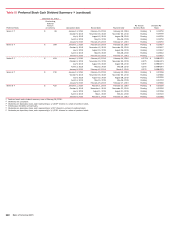Bank of America 2015 Annual Report Download - page 102
Download and view the complete annual report
Please find page 102 of the 2015 Bank of America annual report below. You can navigate through the pages in the report by either clicking on the pages listed below, or by using the keyword search tool below to find specific information within the annual report.
100 Bank of America 2015
For more information on MSRs, including the sensitivity of
weighted-average lives and the fair value of MSRs to changes in
modeled assumptions, see Note 23 – Mortgage Servicing Rights
to the Consolidated Financial Statements.
Fair Value of Financial Instruments
We classify the fair values of financial instruments based on the
fair value hierarchy established under applicable accounting
guidance which requires an entity to maximize the use of
observable inputs and minimize the use of unobservable inputs
when measuring fair value. Applicable accounting guidance
establishes three levels of inputs used to measure fair value. We
carry trading account assets and liabilities, derivative assets and
liabilities, AFS debt and equity securities, other debt securities,
consumer MSRs and certain other assets at fair value. Also, we
account for certain loans and loan commitments, LHFS, short-term
borrowings, securities financing agreements, asset-backed
secured financings, long-term deposits and long-term debt under
the fair value option.
The fair values of assets and liabilities may include
adjustments, such as market liquidity and credit quality, where
appropriate. Valuations of products using models or other
techniques are sensitive to assumptions used for the significant
inputs. Where market data is available, the inputs used for
valuation reflect that information as of our valuation date. Inputs
to valuation models are considered unobservable if they are
supported by little or no market activity. In periods of extreme
volatility, lessened liquidity or in illiquid markets, there may be
more variability in market pricing or a lack of market data to use
in the valuation process. In keeping with the prudent application
of estimates and management judgment in determining the fair
value of assets and liabilities, we have in place various processes
and controls that include: a model validation policy that requires
review and approval of quantitative models used for deal pricing,
financial statement fair value determination and risk
quantification; a trading product valuation policy that requires
verification of all traded product valuations; and a periodic review
and substantiation of daily profit and loss reporting for all traded
products. Primarily through validation controls, we utilize both
broker and pricing service inputs which can and do include both
market-observable and internally-modeled values and/or valuation
inputs. Our reliance on this information is affected by our
understanding of how the broker and/or pricing service develops
its data with a higher degree of reliance applied to those that are
more directly observable and lesser reliance applied to those
developed through their own internal modeling. Similarly, broker
quotes that are executable are given a higher level of reliance than
indicative broker quotes, which are not executable. These
processes and controls are performed independently of the
business. For additional information, see Note 20 – Fair Value
Measurements and Note 21 – Fair Value Option to the Consolidated
Financial Statements.
In 2014, we implemented an FVA into valuation estimates
primarily to include funding costs on uncollateralized derivatives
and derivatives where we are not permitted to use the collateral
received. This change resulted in a pretax net FVA charge of $497
million at the time of implementation. Significant judgment is
required in modeling expected exposure profiles and in discounting
for the funding risk premium inherent in these derivatives.
Level 3 Assets and Liabilities
Financial assets and liabilities where values are based on
valuation techniques that require inputs that are both
unobservable and are significant to the overall fair value
measurement are classified as Level 3 under the fair value
hierarchy established in applicable accounting guidance. The Level
3 financial assets and liabilities include certain loans, MBS, ABS,
CDOs, CLOs and structured liabilities, highly structured, complex
or long-dated derivative contracts and consumer MSRs. The fair
value of these Level 3 financial assets and liabilities is determined
using pricing models, discounted cash flow methodologies or
similar techniques for which the determination of fair value
requires significant management judgment or estimation.
Table 61 Recurring Level 3 Asset and Liability Summary
December 31
2015 2014
(Dollars in millions)
Level 3
Fair Value
As a %
of Total
Level 3
Assets
As a %
of Total
Assets
Level 3
Fair Value
As a %
of Total
Level 3
Assets
As a %
of Total
Assets
Trading account assets $ 5,634 31.13% 0.26%$ 6,259 28.12% 0.30%
Derivative assets 5,134 28.37 0.24 6,851 30.77 0.33
AFS debt securities 1,432 7.91 0.07 2,555 11.48 0.12
Loans and leases 1,620 8.95 0.08 1,983 8.91 0.09
Mortgage servicing rights 3,087 17.06 0.14 3,530 15.86 0.17
All other Level 3 assets at fair value 1,191 6.58 0.05 1,084 4.86 0.05
Total Level 3 assets at fair value (1) $ 18,098 100.00% 0.84%$ 22,262 100.00% 1.06%
Level 3
Fair Value
As a %
of Total
Level 3
Liabilities
As a %
of Total
Liabilities
Level 3
Fair Value
As a %
of Total
Level 3
Liabilities
As a %
of Total
Liabilities
Derivative liabilities $ 5,575 74.50% 0.30%$ 7,771 76.34% 0.42%
Long-term debt 1,513 20.22 0.08 2,362 23.20 0.13
All other Level 3 liabilities at fair value 395 5.28 0.02 46 0.46 —
Total Level 3 liabilities at fair value (1) $ 7,483 100.00% 0.40%$ 10,179 100.00% 0.55%
(1) Level 3 total assets and liabilities are shown before the impact of cash collateral and counterparty netting related to derivative positions.
























